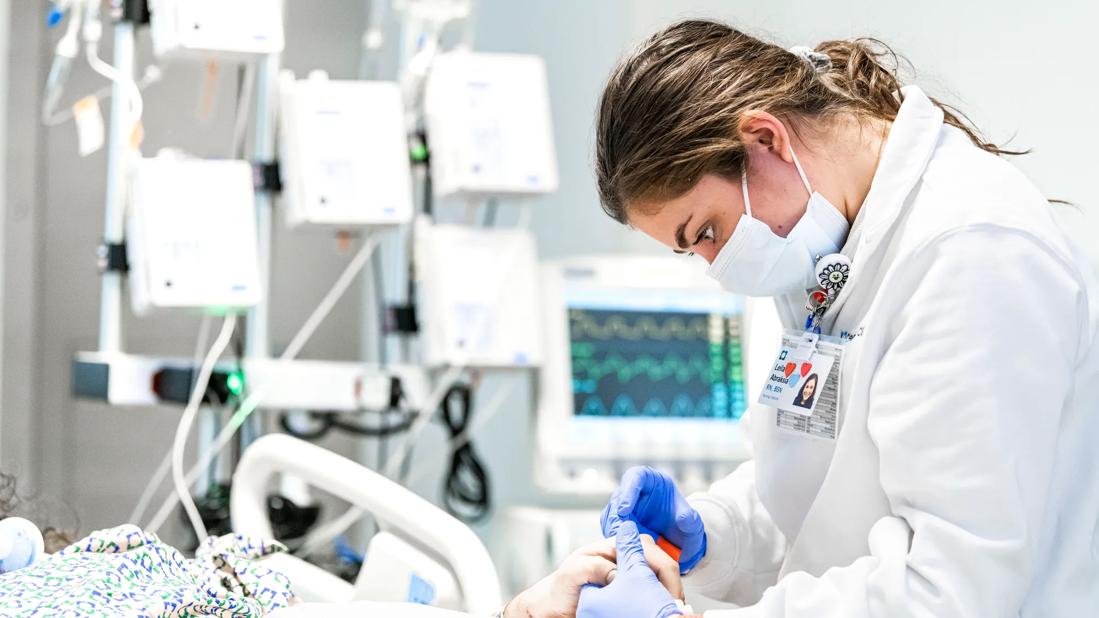A Cleveland Clinic nurse remembers difficulties and triumphs of working during a year like no other.

Kelly Stake, BSN, RN, works at Cleveland Clinic Hillcrest Hospital on a medical surgical unit that focuses on post-operative patients. She decided to pursue a nursing career after taking a school trip to Costa Rica, where she found herself in need of hospital care. The nurse who cared for her inspired her to do the same for others. Stake wrote this essay to share her experience of the pandemic.
Advertisement
Cleveland Clinic is a non-profit academic medical center. Advertising on our site helps support our mission. We do not endorse non-Cleveland Clinic products or services. Policy
In spring of 2020, I left a hectic but beloved post-op unit for four days off, and returned to what honestly felt like an apocalypse. Our unit was converted into COVID-19 unit since it was right above the emergency department. Patients could be taken to a room quickly and without having to be transported across the whole hospital. The entrance had a large sign that read “DO NOT ENTER, CLOSED UNIT.”
The formerly loud and busy hallways were empty, the patient doors were closed with their own version of a bright red sign, and yellow storage cubbies hung over every door, packed full of personal protective equipment. We would all now be COVID-19 nurses.
I remember the cold wave of fear rolling over my body, and immediately calling my family and begging them not to leave the house.
Just like the rest of the world, we were learning something new about the virus, treatment and PPE nearly hourly in the beginning. There were multiple huddles and emails every day to keep the staff updated. At one point I searched on the internet “how to take care of a COVID patient” simply because I had no idea what our patients would need from us.
I found a journal article published out of New York City — what they saw, what they found helped, what didn’t, who was likely to survive, and who wasn’t. It terrified me, but like most nurses, I also felt that the knowledge empowered me.
In the beginning, it was our oldest, most vulnerable patients who we took care of, but as the virus quickly spread throughout the community, those patient demographics changed. We saw younger, seemingly healthy patients being overcome with hypoxia.
Advertisement
We called countless family members and stayed at our patients bedside with a tablet so final goodbyes could be said.
When patients were discharged, we all lined up and clapped and cheered. These fleeting moments of joy soon became a highlight of our long days, weeks and months. The patient had done it, they had beat COVID-19. But so had we. Every patient we sent home was a victory for us, too.
We all battled fear, exhaustion and anxiety in a plastic gown with sweat running down our bodies and N95s rubbing our skin raw, so we could make sure we were not taking the virus home to the ones we love.
Outside of work, I was giving my friends and family frequent updates on how serious the virus was getting. But despite my fiercest warnings, on Thanksgiving Day, my mom and stepdad, Mark, went to a local hospital close to where they live. Both tested positive; Mark was admitted.
Seven days later, just two short hours after Mark texted me for the last time, his oxygen saturation rapidly plummeted. He was intubated, and a chest tube was emergently placed. His caregivers soon lost his pulse. CPR was done for the next two hours. On Dec. 3, 2020, my stepdad — the man who walked me down the aisle — died of the same virus I was tirelessly fighting every day at work.
Mark was a social man, always talking and engaging with anyone in his vicinity. I later learned how severely his time in isolation affected him by reading all his doctors’ notes, which mentioned how lonely Mark was. Ultimately, this is what continues to weigh on my heart. After this point, I went above and beyond to make sure I’m taking the time to give an update to family members. I answered every call, even called them before they called me. I called even if the patient could have made that call themselves. I found the time to give as much comfort as I could over the phone, which was all I had to offer.
Advertisement
Throughout the pandemic, my manager continuously asked me if I needed a break from working on the COVID-19 unit.
I always said no — that I would stay on my unit and see this out. And I did, until — three months after Mark’s passing — his son Jacob, my stepbrother, also died of COVID-19.
I had reached my personal limit. I had cared for these patients day after day and now my family was torn to shreds with grief. It was the kind of grief that keeps you up at night, helplessly thinking through the alternative endings to this story. It was then that I finally took my manager up on her offer to take a break.
Stake has returned to her position in post-operative care, and she continues to be fulfilled by her career as a nurse.
Advertisement
Advertisement

Patients report improved sense of smell and taste

Clinicians who are accustomed to uncertainty can do well by patients

Unique skin changes can occur after infection or vaccine

Cleveland Clinic analysis suggests that obtaining care for the virus might reveal a previously undiagnosed condition

As the pandemic evolves, rheumatologists must continue to be mindful of most vulnerable patients

Early results suggest positive outcomes from COVID-19 PrEP treatment

Could the virus have caused the condition or triggered previously undiagnosed disease?

Five categories of cutaneous abnormalities are associated with COVID-19